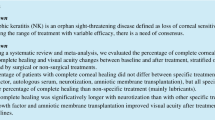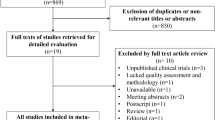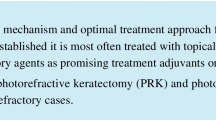Abstract
Purpose of Review
To review and perform a meta-analysis of individual patient data from observational studies describing medical treatment of Pythium keratitis. The outcomes of interest were therapeutic penetrating keratoplasty (TPK) and globe removal (evisceration, enucleation, or exenteration); the main exposures were linezolid and azithromycin use.
Recent Findings
Of 46 eligible articles, individual patient data were available for 306 eyes (34 studies). Pythium keratitis was associated with high rates of TPK (80%, 95% CI 70–87%) and globe removal (25%, 95% CI 13–43). In multivariable models adjusting for age and country, fewer TPKs were performed in patients treated with azithromycin (RR = 0.80, 95% CI 0.67–0.96; P = 0.04) and linezolid (RR = 0.82, 95% CI 0.67–0.99; P = 0.02).
Summary
Studies of Pythium keratitis reported high rates of TPK and globe removal. The use of azithromycin and linezolid was associated with a lower rate of TPK. While promising, these results should be interpreted with caution given the biases inherent to observational studies.



Similar content being viewed by others
References
Gurnani B, Kaur K. Pythium keratitis. In: StatPearls. StatPearls Publishing; 2022. Accessed March 31, 2022. http://www.ncbi.nlm.nih.gov/books/NBK573072/.
Gurnani B, Kaur K, Venugopal A, et al. Pythium insidiosum keratitis - a review. Indian J Ophthalmol. 2022;70(4):1107–20. https://doi.org/10.4103/ijo.IJO_1534_21.
Gurnani B, Christy J, Narayana S, Rajkumar P, Kaur K, Gubert J. Retrospective multifactorial analysis of Pythium keratitis and review of literature. Indian J Ophthalmol. 2021;69(5):1095–101. https://doi.org/10.4103/ijo.IJO_1808_20.
Gurnani B, Kaur K, Agarwal S, et al. Pythium insidiosum keratitis: past, present, and future. Ophthalmol Ther. Published online July 5, 2022. https://doi.org/10.1007/s40123-022-00542-7.
Badenoch PR, Mills RA, Chang JH, Sadlon TA, Klebe S, Coster DJ. Pythium insidiosum keratitis in an Australian child. Clin Experiment Ophthalmol. 2009;37(8):806–9. https://doi.org/10.1111/j.1442-9071.2009.02135.x.
Barequet IS, Lavinsky F, Rosner M. Long-term follow-up after successful treatment of Pythium insidiosum keratitis in Israel. Semin Ophthalmol. 2013;28(4):247–50. https://doi.org/10.3109/08820538.2013.788676.
Bernheim D, Dupont D, Aptel F, et al. Pythiosis: case report leading to new features in clinical and diagnostic management of this fungal-like infection. Int J Infect Dis. 2019;86:40–3. https://doi.org/10.1016/j.ijid.2019.06.011.
Lelievre L, Borderie V, Garcia-Hermoso D, et al. Imported Pythium insidiosum keratitis after a swim in Thailand by a contact lens-wearing traveler. Am J Trop Med Hyg. 2015;92(2):270–3. https://doi.org/10.4269/ajtmh.14-0380.
Maeno S, Oie Y, Sunada A, et al. Successful medical management of Pythium insidiosum keratitis using a combination of minocycline, linezolid, and chloramphenicol. Am J Ophthalmol Case Rep. 2019;15:100498. https://doi.org/10.1016/j.ajoc.2019.100498.
Murdoch D, Parr D. Pythium insidiosum keratitis. Aust N Z J Ophthalmol. 1997;25(2):177–9. https://doi.org/10.1111/j.1442-9071.1997.tb01304.x.
Neufeld A, Seamone C, Maleki B, Heathcote JG. Pythium insidiosum keratitis: a pictorial essay of natural history. Can J Ophthalmol. 2018;53(2):e48–50. https://doi.org/10.1016/j.jcjo.2017.07.002.
Ros Castellar F, Sobrino-Jiménez C, del-Hierro-Zarzuelo A, Herrero-Ambrosio A, Boto-de-los-Bueis A. Intraocular minocycline for the treatment of ocular pythiosis. Am J Health-Syst Pharm. 2017;74(11):821–5. https://doi.org/10.2146/ajhp160248.
Tanhehco TY, Stacy RC, Mendoza L, Durand ML, Jakobiec FA, Colby KA. Pythium insidiosum Keratitis in Israel. Eye Contact Lens. 2011;37(2):96–8. https://doi.org/10.1097/ICL.0b013e3182043114.
Virgile R, Perry HD, Pardanani B, et al. Human infectious corneal ulcer caused by Pythium insidiosum. Cornea. 1993;12(1):81–3. https://doi.org/10.1097/00003226-199301000-00015.
Rathi A, Chakrabarti A, Agarwal T, et al. Pythium keratitis leading to fatal cavernous sinus thrombophlebitis. Cornea. 2018;37(4):519–22. https://doi.org/10.1097/ICO.0000000000001504.
Hasika R, Lalitha P, Radhakrishnan N, Rameshkumar G, Prajna NV, Srinivasan M. Pythium keratitis in South India: incidence, clinical profile, management, and treatment recommendation. Indian J Ophthalmol. 2019;67(1):42–7. https://doi.org/10.4103/ijo.IJO_445_18.
Bagga B, Sharma S, Guda SJM, et al. Leap forward in the treatment of Pythium insidiosum keratitis. Br J Ophthalmol. 2018;102(12):1629–33. https://doi.org/10.1136/bjophthalmol-2017-311360.
Permpalung N, Worasilchai N, Manothummetha K, et al. Clinical outcomes in ocular pythiosis patients treated with a combination therapy protocol in Thailand: a prospective study. Med Mycol. 2019;57(8):923–8. https://doi.org/10.1093/mmy/myz013.
Agarwal S, Iyer G, Srinivasan B, Agarwal M, PanchalamSampath Kumar S, Therese LK. Clinical profile of Pythium keratitis: perioperative measures to reduce risk of recurrence. Br J Ophthalmol. 2018;102(2):153–7. https://doi.org/10.1136/bjophthalmol-2017-310604.
Agarwal S, Iyer G, Srinivasan B, et al. Clinical profile, risk factors and outcome of medical, surgical and adjunct interventions in patients with Pythium insidiosum keratitis. Br J Ophthalmol. 2019;103(3):296–300. https://doi.org/10.1136/bjophthalmol-2017-311804.
Agarwal S, Srinivasan B, Janakiraman N, et al. Role of topical ethanol in the treatment of Pythium insidiosum keratitis-a proof of concept. Cornea. 2020;39(9):1102–7. https://doi.org/10.1097/ICO.0000000000002370.
Anutarapongpan O, Thanathanee O, Worrawitchawong J, Suwan-Apichon O. Role of confocal microscopy in the diagnosis of Pythium insidiosum keratitis. Cornea. 2018;37(2):156–61. https://doi.org/10.1097/ICO.0000000000001466.
Badenoch PR, Mills RAD, Chang JH, Sadlon TA, Klebe S, Coster DJ. Pythium insidiosum keratitis in an Australian child. Clin Exp Ophthalmol. 2009;37(8):806–9. https://doi.org/10.1111/j.1442-9071.2009.02135.x.
Bagga B, Sharma S, Madhuri Guda SJ, et al. Leap forward in the treatment of Pythium insidiosum keratitis. Br J Ophthalmol. 2018;102(12):1629–33. https://doi.org/10.1136/bjophthalmol-2017-311360.
Barequet IS, Lavinsky F, Rosner M. Long-term follow-up after successful treatment of Pythium insidiosum keratitis in Israel. Semin Ophthalmol. 2013;28(4):247–50. https://doi.org/10.3109/08820538.2013.788676.
Bernheim D, Dupont D, Aptel F, et al. Pythiosis: case report leading to new features in clinical and diagnostic management of this fungal-like infection. Int J Infect Dis. 2019;86:40–3. https://doi.org/10.1016/j.ijid.2019.06.011.
Chatterjee S, Agrawal D. Azithromycin in the management of Pythium insidiosum keratitis. Cornea. 2018;37(2):e8–9. https://doi.org/10.1097/ICO.0000000000001419.
Gurnani B, Christy J, Narayana S, Rajkumar P, Kaur K, Gubert J. Retrospective multifactorial analysis of Pythium keratitis and review of literature. Indian J Ophthalmol. 2021;69(5):1095–101. https://doi.org/10.4103/ijo.IJO_1808_20.
Hasika R, Lalitha P, Radhakrishnan N, Rameshkumar G, Prajna NV, Srinivasan M. Pythium keratitis in South India: incidence, clinical profile, management, and treatment recommendation. Indian J Ophthalmol. 2019;67(1):42–7. https://doi.org/10.4103/ijo.IJO_445_18.
He H, Liu H, Chen X, Wu J, He M, Zhong X. Diagnosis and treatment of Pythium insidiosum corneal ulcer in a Chinese child: a case report and literature review. Am J Case Rep. 2016;17:982–8. https://doi.org/10.12659/ajcr.901158.
Hou H, Wang Y, Tian L, Wang F, Sun Z, Chen Z. Pythium insidiosum keratitis reported in China, raising the alertness to this fungus-like infection: a case series. J Med Case Rep. 2021;15(1):619. https://doi.org/10.1186/s13256-021-03189-3.
Kate A, Bagga B, Ahirwar LK, Mishra DK, Sharma S. Unusual presentation of Pythium keratitis as peripheral ulcerative keratitis: clinical dilemma. Ocul Immunol Inflamm. Published online August 19, 2021; 1–4. https://doi.org/10.1080/09273948.2021.1952276.
Kunavisarut S, Nimvorapan T, Methasiri S. Pythium corneal ulcer in Ramathibodi Hospital. J Med Assoc Thai. 2003;86(4):338–42.
Lekhanont K, Chuckpaiwong V, Chongtrakool P, Aroonroch R, Vongthongsri A. Pythium insidiosum keratitis in contact lens wear: a case report. Cornea. 2009;28(10):1173–7. https://doi.org/10.1097/ICO.0b013e318199fa41.
Lelievre L, Borderie V, Garcia-Hermoso D, et al. Imported Pythium insidiosum keratitis after a swim in Thailand by a contact lens-wearing traveler. Am J Trop Med Hyg. 2015;92(2):270–3. https://doi.org/10.4269/ajtmh.14-0380.
Maeno S, Oie Y, Sunada A, et al. Successful medical management of Pythium insidiosum keratitis using a combination of minocycline, linezolid, and chloramphenicol. Am J Ophthalmol Case Rep. 2019;15:100498. https://doi.org/10.1016/j.ajoc.2019.100498.
Mittal R, Jena SK, Desai A, Agarwal S. Pythium insidiosum keratitis: histopathology and rapid novel diagnostic staining technique. Cornea. 2017;36(9):1124–32. https://doi.org/10.1097/ICO.0000000000001244.
Murdoch D, Parr D. Pythium insidiosum keratitis. Aust N Z J Ophthalmol. 1997;25(2):177–9. https://doi.org/10.1111/j.1442-9071.1997.tb01304.x.
Nonpassopon M, Jongkhajornpong P, Aroonroch R, Koovisitsopit A, Lekhanont K. Predisposing factors, clinical presentations, and outcomes of contact lens-related Pythium keratitis. Cornea. 2021;40(11):1413–9. https://doi.org/10.1097/ICO.0000000000002651.
Permpalung N, Worasilchai N, Plongla R, et al. Treatment outcomes of surgery, antifungal therapy and immunotherapy in ocular and vascular human pythiosis: a retrospective study of 18 patients. J Antimicrob Chemother. 2015;70(6):1885–92. https://doi.org/10.1093/jac/dkv008.
Puangsricharern V, Chotikkakamthorn P, Tulvatana W, et al. Clinical characteristics, histopathology, and treatment outcomes of Pythium keratitis: a retrospective cohort study. Clin Ophthalmol. 2021;15:1691–701. https://doi.org/10.2147/OPTH.S303721.
Raghavan A, Bellamkonda P, Mendoza L, Rammohan R. Pythium insidiosum and acanthamoeba keratitis in a contact lens user. BMJ Case Rep. 2018;11(1):bcr-2018-226386. https://doi.org/10.1136/bcr-2018-226386.
Ramappa M, Nagpal R, Sharma S, Chaurasia S. Successful medical management of presumptive Pythium insidiosum keratitis. Cornea. 2017;36(4):511–4. https://doi.org/10.1097/ICO.0000000000001162.
Rathi A, Chakrabarti A, Agarwal T, et al. Pythium keratitis leading to fatal cavernous sinus thrombophlebitis. Cornea. 2018;37(4):519–22. https://doi.org/10.1097/ICO.0000000000001504.
Ros Castellar F, Sobrino Jiménez C, del Hierro Zarzuelo A, Herrero Ambrosio A, Boto de Los Bueis A. Intraocular minocycline for the treatment of ocular pythiosis. Am J Health Syst Pharm. 2017;74(11):821–5. https://doi.org/10.2146/ajhp160248.
Sharma S, Balne PK, Motukupally SR, et al. Pythium insidiosum keratitis: clinical profile and role of DNA sequencing and zoospore formation in diagnosis. Cornea. 2015;34(4):438–42. https://doi.org/10.1097/ICO.0000000000000349.
Sharma S, Rathi VM, Murthy SI, Garg P, Sharma S. Application of trypan blue stain in the microbiological diagnosis of infectious keratitis-a case series. Cornea. 2021;40(12):1624–8. https://doi.org/10.1097/ICO.0000000000002725.
Tanhehco TY, Stacy RC, Mendoza L, Durand ML, Jakobiec FA, Colby KA. Pythium insidiosum keratitis in Israel. Eye Contact Lens. 2011;37(2):96–8. https://doi.org/10.1097/ICL.0b013e3182043114.
Thanathanee O, Bhoomibunchoo C, Anutarapongpan O, Suwan-Apichon O, Charoensuk K, Chindamporn A. Role of immunotherapy in Pythium insidiosum keratitis. Am J Trop Med Hyg. 2022;107(1):110–2. https://doi.org/10.4269/ajtmh.22-0015.
Thanathanee O, Enkvetchakul O, Rangsin R, Waraasawapati S, Samerpitak K, Suwan-apichon O. Outbreak of Pythium keratitis during rainy season: a case series. Cornea. 2013;32(2):199–204. https://doi.org/10.1097/ICO.0b013e3182535841.
Virgile R, Perry HD, Pardanani B, et al. Human infectious corneal ulcer caused by Pythium insidiosum. Cornea. 1993;12(1):81–3. https://doi.org/10.1097/00003226-199301000-00015.
Vishwakarma P, Mohanty A, Kaur A, et al. Pythium keratitis: clinical profile, laboratory diagnosis, treatment, and histopathology features post-treatment at a tertiary eye care center in Eastern India. Indian J Ophthalmol. 2021;69(6):1544–52. https://doi.org/10.4103/ijo.IJO_2356_20.
Rogers GM, Goins KM, Sutphin JE, Kitzmann AS, Wagoner MD. Outcomes of treatment of fungal keratitis at the University of Iowa Hospitals and Clinics: a 10-year retrospective analysis. Cornea. 2013;32(8):6.
Jurkunas U, Behlau I, Colby K. Fungal keratitis: changing pathogens and risk factors. Cornea. 2009;28(6):6.
Wong TY, Ng TP, Fong KS, Tan DT. Risk factors and clinical outcomes between fungal and bacterial keratitis: a comparative study. CLAO J. 1997;23(4):275–81.
Robaei D, Carnt N, Minassian DC, Dart JKG. The impact of topical corticosteroid use before diagnosis on the outcome of acanthamoeba keratitis. Ophthalmology. 2014;121(7):1383–8. https://doi.org/10.1016/j.ophtha.2014.01.031.
Bouheraoua N, Gaujoux T, Goldschmidt P, Chaumeil C, Laroche L, Borderie VM. Prognostic factors associated with the need for surgical treatments in acanthamoeba keratitis. Cornea. 2013;32(2):130–6. https://doi.org/10.1097/ICO.0b013e31826429bd.
Chitasombat MN, Jongkhajornpong P, Lekhanont K, Krajaejun T. Recent update in diagnosis and treatment of human pythiosis. PeerJ. 2020;8:e8555. https://doi.org/10.7717/peerj.8555.
Jesus FPK, Loreto ÉS, Ferreiro L, et al. In vitro and in vivo antimicrobial activities of minocycline in combination with azithromycin, clarithromycin, or tigecycline against Pythium insidiosum. Antimicrob Agents Chemother. 2015;60(1):87–91. https://doi.org/10.1128/AAC.01480-15.
Ahirwar LK, Kalra P, Sharma S, et al. Linezolid shows high safety and efficacy in the treatment of Pythium insidiosum keratitis in a rabbit model. Exp Eye Res. 2021;202:108345. https://doi.org/10.1016/j.exer.2020.108345.
Medhasi S, Chindamporn A, Worasilchai N. A review: antimicrobial therapy for human pythiosis. Antibiotics. 2022;11(4):450. https://doi.org/10.3390/antibiotics11040450.
Funding
This project was supported by the Fogarty International Center of the National Institutes of Health (NIH) under Award Number D43TW009343 and the University of California Global Health Institute (UCGHI). The work was also supported by the All May See Foundation and Research to Prevent Blindness.
Author information
Authors and Affiliations
Corresponding author
Ethics declarations
Conflict of Interest
The authors declare no competing interests.
Disclaimer
The content is solely the responsibility of the authors and does not necessarily represent the official views of the NIH or UCGHI.
Additional information
Publisher's Note
Springer Nature remains neutral with regard to jurisdictional claims in published maps and institutional affiliations.
This article is part of the Topical Collection on Ocular Surface
Rights and permissions
Springer Nature or its licensor (e.g. a society or other partner) holds exclusive rights to this article under a publishing agreement with the author(s) or other rightsholder(s); author self-archiving of the accepted manuscript version of this article is solely governed by the terms of such publishing agreement and applicable law.
About this article
Cite this article
Cao, B., Gonugunta, V.T., Radhakrishnan, N. et al. Outcomes of Pythium keratitis: A Meta-Analysis of Individual Patient Data. Curr Ophthalmol Rep 10, 198–208 (2022). https://doi.org/10.1007/s40135-022-00302-7
Accepted:
Published:
Issue Date:
DOI: https://doi.org/10.1007/s40135-022-00302-7




